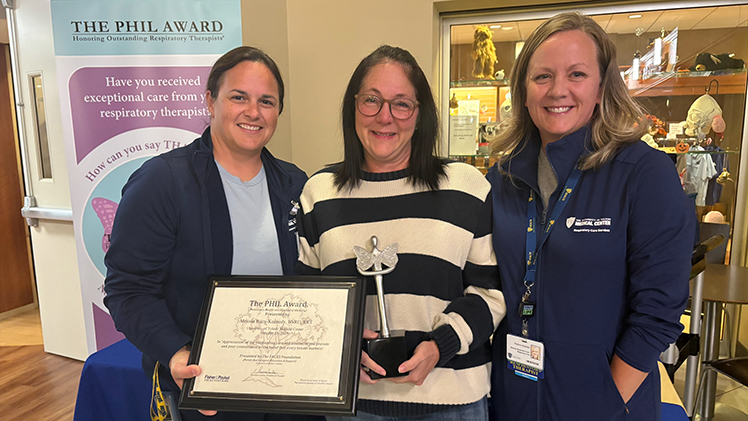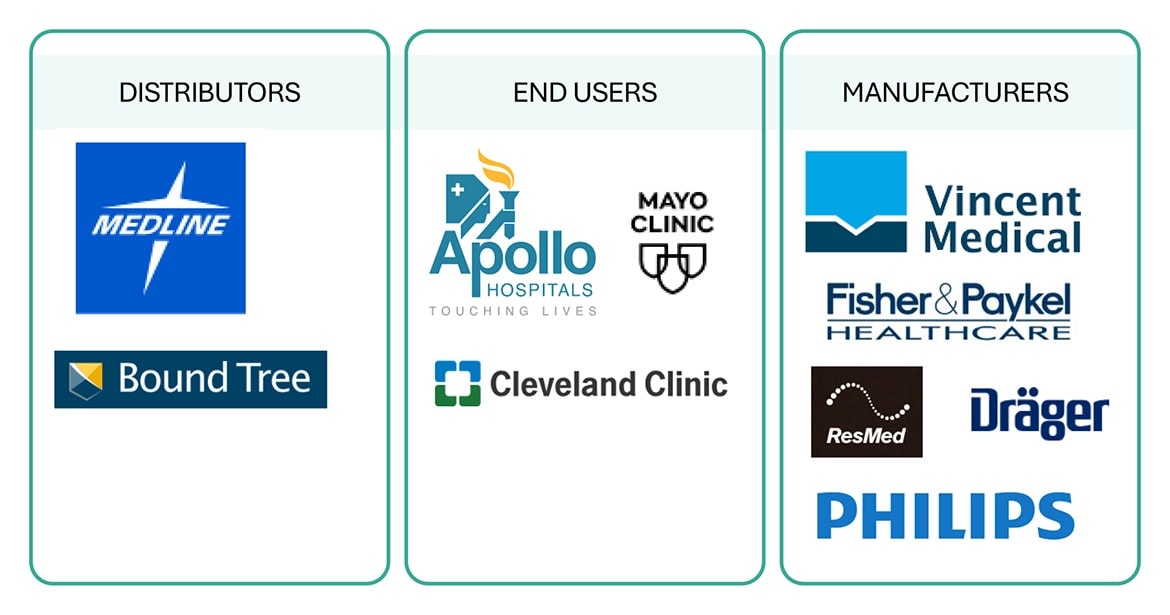Fall back, quiet respiratory season, SNAP expiration and good news

It’s November! Time for us Scorpios to shine.
This week, we’re talking about falling back (literally and figuratively). From SNAP beneficiaries missing payments on November 1, to falling back on our broken health care system as open enrollment begins, to the time change messing with our health, a lot is shifting. We’re also flying a bit blind when it comes to respiratory disease data, but I’ve pieced together the best snapshot I can from different sources. There’s also always some good news to share! And, finally, we need your help: take a quick survey to help us learn how you’re using AI tools for health information.
Here we go!

Where are all my tired moms at? “Spring forward, fall back”—and children are waking up an hour earlier, of course. Over the weekend, clocks changed. This practice—a polarizing one—has been observed for over a century in an attempt to reduce energy use. In the U.S., most states follow this rule, except Arizona, Hawaii, and some territories. (Hello, Puerto Rico!)
This isn’t just annoying; there are health impacts:
-
In the spring, when we lose an hour of sleep and wake up in the dark, our circadian rhythms are disrupted, making it harder to get up and function. Fatal car accidents rise by about 6%, heart attacks spike by 24%, and rates of abnormal heart rhythms and inflammation increase.
-
In the fall, shorter days and reduced light exposure (sunsets are earlier) are linked to higher rates of depressive episodes.
Research shows that keeping one time year-round—either standard or daylight saving—would be healthier. Modeling studies that account for light, circadian effects, and health outcomes suggest that adopting a permanent system could prevent hundreds of thousands of strokes and lower obesity rates. While more evidence is needed, these findings give policymakers a clearer picture of what’s at stake.
Last week, a bill aiming to make daylight saving time permanent (the Sunshine Protection Act), authored by Florida U.S. Sen. Rick Scott, and backed by President Donald Trump, was blocked by Arkansas Sen. Tom Cotton. That means that, unfortunately, without Congressional approval, the 19 states that have passed laws for permanent daylight saving time cannot act.
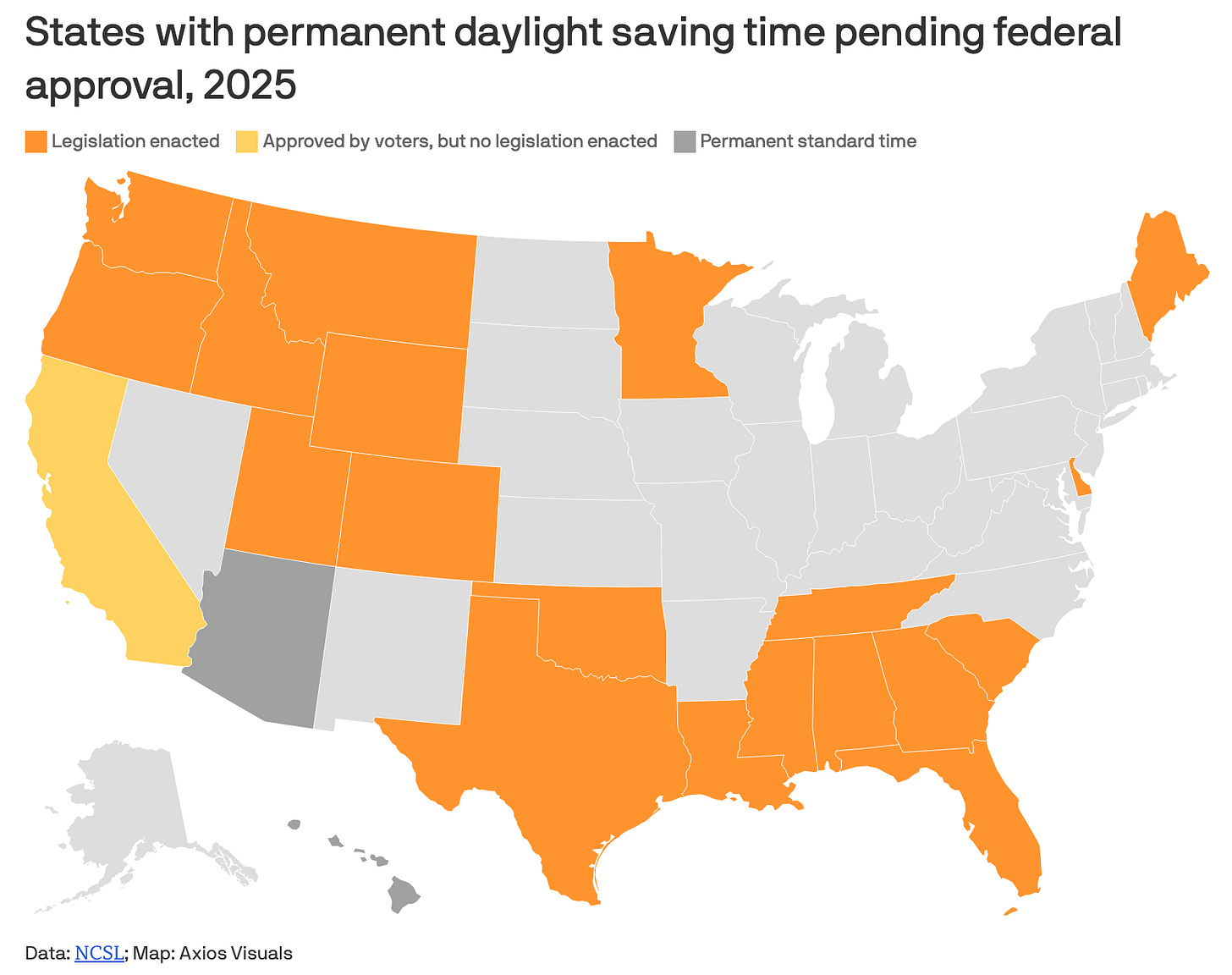
What this means for you: The biggest health impact comes when we “spring forward.” But as you adjust to “fall back,” make time for daylight exposure during the day—it helps recalibrate your sleep and mood. (We noted how you can improve sleep by adjusting light exposure, for example, in an earlier Dose.)
-
SNAP fell back. For the first time in history, SNAP benefits didn’t go out as scheduled. Two federal judges have since ordered the USDA to release the funds, but it’s taking time, and that uncertainty is straining families. Calls to 211 are up 97% compared to the rest of the year, according to researchers at WashU. Not all 42 million recipients receive benefits on November 1—states stagger benefits by Social Security number or first letter of the last name—so the longer the delay, the more severe the overall public health impact.
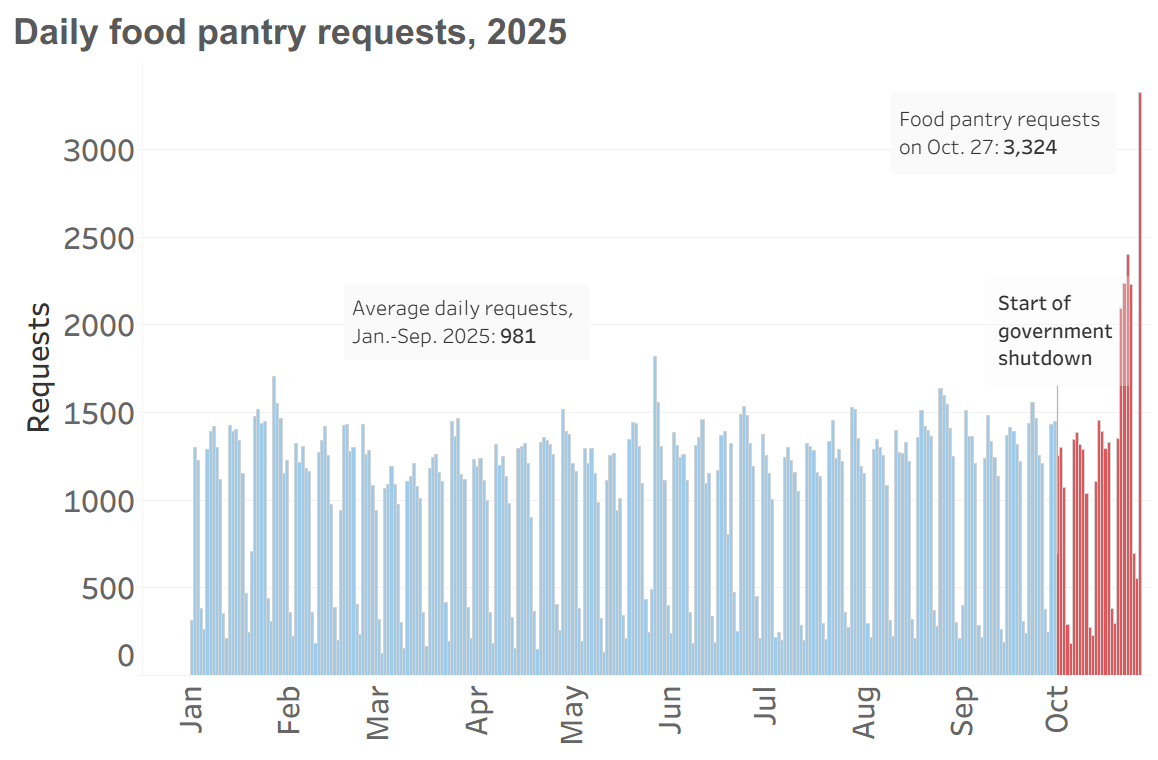
-
Falling back on broken health care. The weekend kicked off open enrollment for Obamacare (ACA), during which more than 20 million families will shop for health insurance coverage. Unfortunately, this will come with sticker shock: a ~30% price hike. The price calculations are assuming that lawmakers won’t extend tax credits. (If there is a deal from the shutdown, prices will go down, but will be higher than last year regardless.)
-
My vaccine uptake anxiety fell back. Normally, we’d have national data on flu and Covid-19 vaccination rates by now. But with the data shutdown, we’re in the dark. When I got my shots last weekend, I asked my pharmacist whether he’d seen any changes in demand. His answer: “No —actually, more people seem to be getting vaccinated this year.”
I’ll be honest, we’re flying a bit blind at the national level right now when it comes to what’s spreading and how. CDC data hasn’t been updated since the shutdown, so we’re missing our usual backbone of information. In the meantime, I’ve been relying on PopHIVE, which pulls data from multiple sources—but it hasn’t been updated since last week (although I’ve heard new data is coming soon).
Here’s what we can piece together: RSV is still low but continues to increase, while flu is just getting started among kiddos.
Here’s how I got there:
-
Scraping state and local health department websites. Shoutout to epidemiologist Dr. Caitlin Rivers for doing that heavy lifting; she mentioned a few places where flu cases are starting to increase.
-
In Google, we’re seeing an uptick in RSV-related searches, especially in Florida, Montana, Idaho, and South Dakota. That aligns with the early signs of an RSV wave we started to see last week. Still, activity remains low overall.
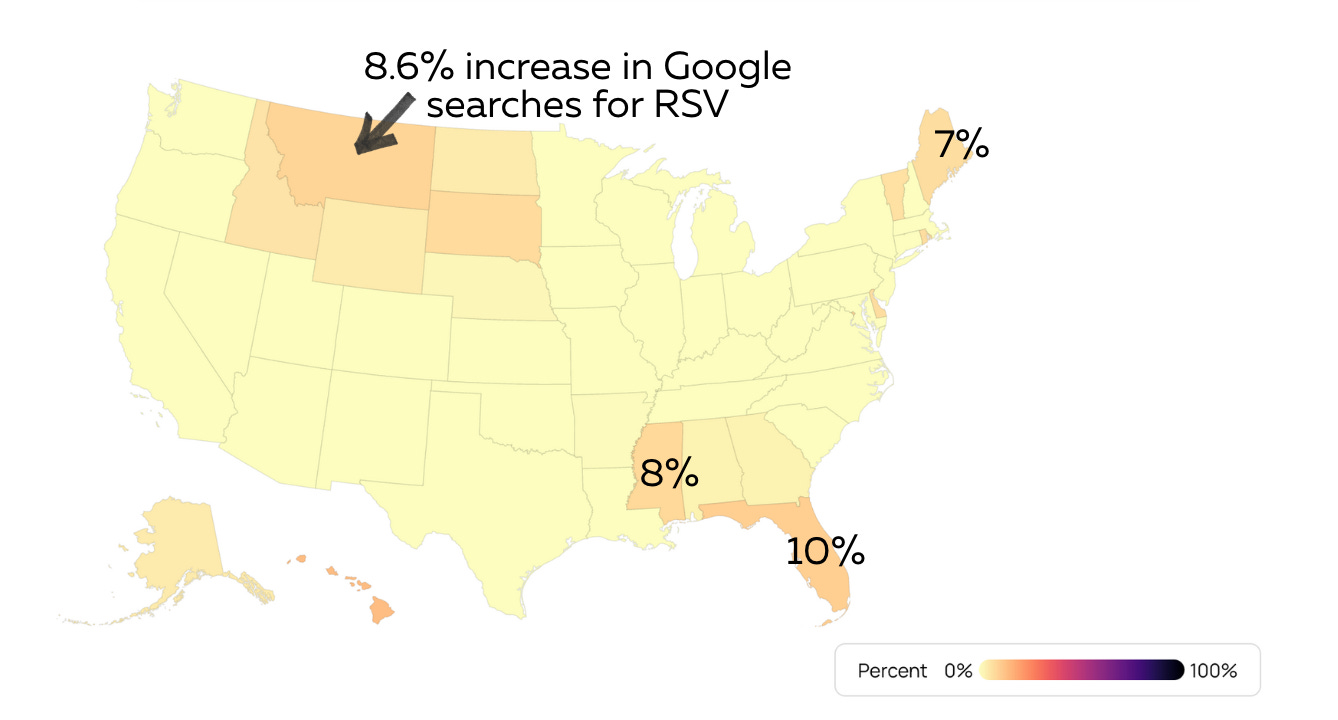
-
Anecdotal data. When I went to get my flu and Covid-19 shots last week, a few people in line were picking up Tamiflu—so it seems flu season might just be getting started too.
-
Private data. One diagnostic tool I found is reporting their data, and it seems like the common cold is really taking the cake. However, it’s unclear to me who is being tested and whether the results are representative of the U.S. population.
Overall, it’s an unusually quiet season. By now, RSV among infants is usually peaking and flu is picking up steam. Why the lull? Viral patterns depend on a complex mix of weather, humidity, human behavior, viral evolution, and unknown unknowns. In other words, we don’t really know.
What this means for you: Enjoy the lull!
Detections are rising across the country, and migratory birds are to blame as well as weather shifts. As the human flu starts to spread, so does flu for animals. Washington and Wisconsin have reported more than 3.5 million and nearly 2 million avian flu detections, respectively, in the past month. The most commercial flocks (12) have been affected in Minnesota.

This is expected, but the the greater the spread, the more chances there are for the virus to mutate. We haven’t seen human-to-human spread yet, but other variants like H5N2 and continued mutations in H5N1 might eventually make that possible. Unfortunately, all human reporting is currently down due to the shutdown, making it difficult to determine if there is human-to-human spread.
People STEPPING UP to fill in SNAP gaps. There isn’t anything good about nonpayment to beneficiaries, but it has been refreshing to see communities step up. Social media is filled with donation campaigns. Schools are sending announcements for food drives. More people are volunteering. As Fred Rogers said, “Look for the helpers. You will always find people who are helping.”
Obesity rates are on a steady decline. Recent results from a Gallup poll, which combined three nationally representative surveys, show that U.S. adult obesity rates continue to decline. The exploding popularity of GLP-1 drugs is part of the explanation here, but these drugs are still not available to everyone because of their relatively high price tag. Epidemiologists are still investigating the reasons behind this decline, but for now, it remains a dramatic phenomenon.
YLE has been thinking a lot about how AI tools are being used for health. We’re hearing from you that you’re turning to these tools with health questions, and we’ve also started exploring how AI could make it easier for you to find helpful advice on topics we cover. What we’ve learned so far is that there are some really cool things happening—and some really important questions that we want to explore together.
Our next webinar—and some upcoming posts—will dig into your questions, and ours, about how artificial intelligence is transforming the way we discover and understand health information. Think ChatGPT, Claude, Co-Pilot, PerplexityAI, Open Evidence, and more. How do these tools work on the backend? What questions should (and shouldn’t) we ask them? And most importantly, when (if ever) can we trust the answers they give?
We want to make sure this conversation is helpful to you. Please take a minute (literally) to complete this quick poll. Stay tuned for the registration link, which will be available soon (early to mid-November).
And that’s it! You’re all caught up for the week.
Love, YLE
Your Local Epidemiologist (YLE) is founded and operated by Dr. Katelyn Jetelina, MPH PhD—an epidemiologist, wife, and mom of two little girls. YLE is a public health newsletter that reaches over 400,000 people in more than 132 countries, with one goal: to translate the ever-evolving public health science so that people are well-equipped to make evidence-based decisions. This newsletter is free to everyone, thanks to the generous support of fellow YLE community members. To support the effort, subscribe or upgrade below:
link


